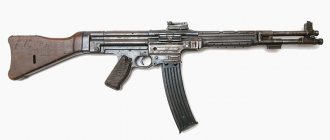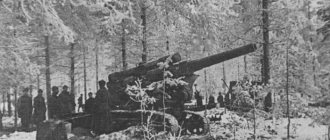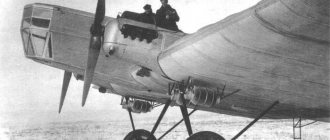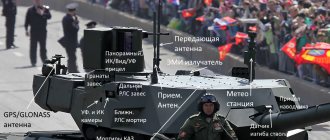Chassepot rifle
Chassepot rifle
(French Fusil modèle 1866) is a single-shot needle rifle developed by the French gunsmith Antoine Chassepot in 1866. Used in the French army in 1866-1874. The Prussian victory at the Battle of Sadovo revealed the advantage of modern weapons (especially the Dreyse rifle) and accelerated the adoption of the Chassepot rifle (Chassepot modèle 1866) into service by the army of the French Empire.
The Chassepot rifle had a sliding bolt that rotated 90° when closing. However, when closing the bolt, the hammer did not cock, as in modern rifles with a sliding bolt [ source not specified 1842 days
], and this required a separate movement. Rifle caliber - 11 mm, total length without bayonet - 131.3 cm, total length with bayonet - 189 cm, weight - 4.1 kg, practical rate of fire up to 15 rounds/min., with aiming - 8-10 shots[2 ], target firing range - 1200 m. The bayonet was attached to the rifle if necessary and was usually worn in an iron sheath on the belt.
The Chassepot rifle had all the basic design features that later became characteristic of single-shot and repeating bolt-action rifles. Even externally, its shutter was very similar to modern ones. Like the Dreyse rifle, it had a sliding bolt that was locked by turning. The Chassepot rifle had a more advanced bolt sealing system to prevent breakthrough of powder gases (which, in the absence of a metal sleeve, was an obvious problem with needle rifles), with a rubber o-ring that was heard when fired under the pressure of powder gases. However, the rubber rings burned out quite quickly, requiring frequent replacement, but subsequently a similar system, only with an asbestos gasket, was implemented in French artillery guns - the Debange seal. Secondly, the primer in its paper cartridge was located not in the bullet tray, but at the base of the cartridge case, which made it possible to shorten the needle and make the weapon truly reliable. In addition, the powerful 11-mm cartridge gave it very good ballistics for its time. The cartridge used was paper, but the primer was in a cardboard tray, so the firing pin needle was much shorter than the needle of the Dreyse rifle (in which the needle pierced the entire cartridge case all the way to the “spiegel” - the folder tray of the bullet) and stronger. The compression system bullet, expanding under the action of powder gases, cut into the rifling itself, so there was also no need for a bullet pan. There was no extractor, since the cartridge burned out when fired, and its unburnt remains were pushed out by the bullet of the new cartridge during the next shot - although not completely, which led to clogging of the mechanism with cardboard residues, paper and gunpowder fumes.
The bolt of a Chassepot rifle.
Internal structure of the Chasspo system.
Bolt obturation Shutter of the Chassepot rifle.
Details of the Chassepot rifle.
Chassepot paper cartridges Chassepot paper cartridge and metal cartridge 11 × 59 mm R of the fusil Modèle 1866/74 conversion rifle
Paper chassepot
Cartridges for Dreyse rifles and Chassepot rifles Cartridges for needle rifles: Dreyse on the left, Chassepot in the center
Bladed weapons of Bulgaria
Needle bayonet for the Russian rifle Krnka mod. 1869
In the 1860s, the War Ministry of the Russian Empire actively sought the possibility of quickly re-equipping the army with rifled breech-loading weapons chambered for cartridges with metal sleeves. Along with the development and search for new models of such weapons, special attention was paid to the possibility of converting existing muzzle-loading models into breech-loading ones. The attention of the War Ministry was attracted by the model of a Czech gunsmith, an Austrian citizen Sylvester Krnka [for some reason in Russian-language literature it is not customary to decline the surname Krnka by case, but according to the rules of the Russian language, this surname, although foreign, is declined].
The main advantage of the model was the simplicity of its design and the ease with which Russian 6-line (15.24 mm) muzzle-loading rifles mod. 1856 (rifle) and mod. 1858 (infantry). The redesigned model was approved on March 18, 1869 (in Western sources the rifle is designated M1867 Russian Krnka; why 1867?). Rework work was carried out en masse both at state arms factories (Tula, Sestroretsk and Izhevsk) and at private enterprises (in particular, in Kyiv and Libau).
The Krnka rifle was produced in infantry, rifle and dragoon versions (somewhere in the sources there is also information about the Cossack version):
Bolt group of Krnka rifles:
Russian 6-line (15.24 mm) cartridges for Krnka rifles:
Krnka rifles mod. 1869, converted from small rifles mod. 1856:
Spoiler
Krnka rifles in small arms version (details)
Krnka rifles mod. 1869, converted from infantry rifles mod. 1858:
Spoiler
Krnka rifles in infantry version (details)
Krnka Dragoon Rifle:
Spoiler
Krnka Dragoon Rifle
Here are also “incomprehensible” (“hybrid”: in length, like dragoon rifles, and the belt fastening is like that of infantry/small rifles) variants of the Krnka rifle (maybe carbines?):
Russian soldiers gave the Krnka rifle the nickname “krynka”.
Spoiler
RIA servicemen with Krnka rifles
For the Krnka rifle mod. 1869 relied on the same needle bayonet,
... as for the small rifle mod. 1856 and to the infantry rifle mod. 1858.
Small arms and infantry rifles differed only in their sights:
Russian rifle rifles mod. 1856:
Russian infantry rifle mod. 1858:
Also, photographs of Russian rifles of the 1856 and 1858 models can be seen in the special issue of the magazine “Weapons” No. 11 for 2013. It contains an article by Alexey Klishin “Russian small arms of the Crimean War.”
This bayonet was also used for the conversion rifle of the Terry-Norman system mod. 1866 and a reworked needle rifle of the Karl system arr. 1867, which were in service with the Russian Imperial Army.
Spoiler
Terry-Norman rifle mod. 1866 (by the way, Ivan Norman is a Russian gunsmith)
Spoiler
Karle rifle mod. 1867
The design of the bayonet is similar to the bayonet for the rifled gun of the Life Guards Rifle Regiment of the Imperial Family mod. 1854 and differs from it only in size and blued surface.
The needle blade of the bayonet for the Krnka rifle is triangular.
In cross-section, the blade has the shape of a triangle, the base of which is much larger than the other two sides. The wide base is turned towards the barrel to eliminate the possibility of injuring your hand when loading a shotgun/rifle from the muzzle (this was important for muzzle-loading small arms and infantry rifles).
The neck of the bayonet has an oval cross-section. A tube with a mule, a two-armed slot going from bottom to left, and a clamp.
Main overall dimensions of the Russian needle bayonet for the Krnka rifle mod. 1869:
- total length - 570 mm;
– blade length – 500 mm;
— blade width – 22 mm;
— tube length – 67.4 mm;
— internal diameter of the tube is 21.3 mm.
Spoiler
Needle bayonet for the Russian rifle Krnka mod. 1869
Bayonet for the Krnka dragoon rifle in a sheath of a Russian saber mod. 1841:
Krnka rifle with fixed bayonet:
Spoiler
Articles (in French) about Crnka rifles
In these videos you can look at the Krnka rifles:
1)
2)
ReplyQuote











